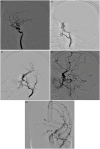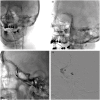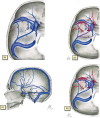Dural arteriovenous fistula in the sphenoid bone lesser wing region: Endovascular adjuvant techniques of treatment and literature review
- PMID: 29848145
- PMCID: PMC6116136
- DOI: 10.1177/1591019918777233
Dural arteriovenous fistula in the sphenoid bone lesser wing region: Endovascular adjuvant techniques of treatment and literature review
Abstract
This article describes the successful endovascular treatment of a dural arteriovenous fistula of a rare localization (the area of sphenoid bone lesser region). We examine one report of an unusually located dural arteriovenous fistula successfully treated with Onyx (ev3, Irvine, USA) using a combination of endovascular adjuvant techniques: pressure cooker and remodeling balloon protection of cerebral artery. The article includes previously published observations of such fistulas and discusses anatomic features and venous drainage of dural arteriovenous fistulas in the given location.
Keywords: Arteriovenous malformation; Onyx; endovascular treatment; technical aspects.
Figures





References
-
- Cognard C, Gobin YP, Pierot L, et al. Cerebral dural arteriovenous fistulas: Clinical and angiographic correlation with a revised classification of venous drainage. Radiology 1995; 194: 671–680. - PubMed
-
- Bitoh S, Arita N, Fujiwara M, et al. Dural arteriovenous malformation near the left sphenoparietal sinus. Surg Neurol 1980; 13: 345–349. - PubMed
-
- Tsutsumi K, Shiokawa Y, Kubota M, et al. Postoperative arteriovenous fistula between the middle meningeal artery and sphenoparietal sinus. Neurosurgery 1990; 26: 869–870. - PubMed
-
- Ezura M, Takahashi A, Mizoi K. Dural arteriovenous shunts involving the sphenoparietal sinus. A case report. Interv Neuroradiol 1996; 2: 223–228. - PubMed
Publication types
MeSH terms
Substances
LinkOut - more resources
Full Text Sources
Other Literature Sources

